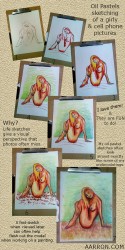I do a lot of sketching.
Most of the time they end up going no place, but the exercise alone is worth it and often fun.
Oil pastels are one of my favorite things to work with because the finished sketch looks very similar to the way I usually under-paint for my paintings.
The process is also super fast with an actual finished look.
Unlike chalks, charcoal, pencils, and ink.
(Ink is my overall fave to sketch with though)
Lets look at a process series of an oil pastel figure sketch.
(Click the pic to see it big)
As you can see I start off with a basic line sketch.
I almost always do that. Maybe it is because I enjoy inks, maybe it is from years of tattooing.
Not sure, but shadow sketching isn’t my bag.
My goal with a sketch is to capture the basic essence of a person/figure/thing.
Speed is important.
If I slow down and start working details I get sidetracked on trivialities and miss out on the important aspects of shape and form.
So…
step 1) basic shape line sketch.
step 2) heavy shadows and weights.
step 3) secondary shadows and weights.
step 4) fleshing the idea/image into a workable image by hitting tertiary shade zones and creation of depth and outside shadow sources.
step 5) basic blending and adding to primary shadows along with touches of highlights.
step 6) final shadowing and highlighting along with background shapes/shadows/textures/etc…
step 7) blending, refining of light sources, textures, and correction of lines.
Done.
If my going fast fucks shit up then so be it.
It is a sketch, not a commissioned work of art.
Another reason to go fast is that one sketch is rarely enough.
A model gets impatient and fidgety after a while unless you set them to doing something like reading a book or watching TV = no body expression.
So there you have have it.
Hope you enjoyed my brief take on my oil pastel sketching.
NOTES:
1) This was on 9″ wide x 12″ high regular white sketch paper.
Such paper is smooth. Most people like a grit to the paper when working with oil pastels. I often use watercolor papers when I wish more tooth.
For fast sketches however I go thin and low cost = regular sketch paper.
Watercolor paper is in my mind a waste for something that will most likely end up in the trash either because of art failure or it being used as a rough for a painting.
2) To blend my oil pastels I primarily use chunks of paper towels, my fingers, and white oil pastels which I buy in bulk.
3) After a sketch is complete I let it dry a day or two and then pick off or roll off the excess chunks of pastel that clump up on smooth papers.
To avoid this go with a rougher paper.
You can see an example of one of my figure sketches in oil pastel on a rougher paper here.
It was done on cold-press watercolor paper.


Leave a Reply